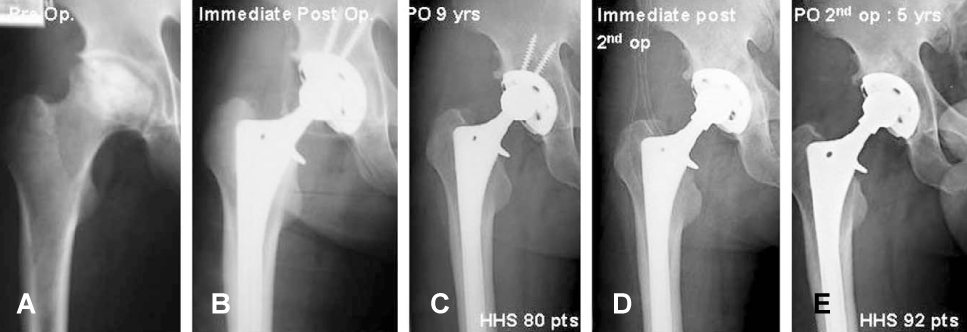J Korean Hip Soc.
2010 Mar;22(1):58-65. 10.5371/jkhs.2010.22.1.58.
Management of Osteolysis around a Stable Harris-Galante Acetabular Cup: Retention vs Revision of the Acetabular Component
- Affiliations
-
- 1Department of Orthopedic Surgery, Korea University Anam Hospital, College of Medicine, Korea University, Seoul, Korea. parksw@korea.ac.kr
- KMID: 1461079
- DOI: http://doi.org/10.5371/jkhs.2010.22.1.58
Abstract
- PURPOSE
We analyzed and compared 30 clinical cases of acetabular osteolysis around a stably fixed acetabular cup, and this was managed by changing the liner along with retaining or revising the cup.
MATERIALS AND METHODS
We analyzed 30 patients who underwent acetabular component revision or retention with a bone graft for osteolysis around a stably fixed Harris-Galante acetabular cup and these patients were followed up for more than 2 years. There were 7 cases with a conserved the acetabular cup and only the liner was changed, and 23 cases with a totally revised acetabular component. We compared the size of the acetabular cup, the thickness of the polyethylene liner, the progression of osteolysis and the clinical outcomes.
RESULTS
The Harris hip score was improved in both groups. In the retention group, during an average of 59.9 months of follow up, 7 cases showed stable fixation and 3 cases showed locally advanced osteolysis. In the revision group, during an average of 57.2 months of follow up, all 20 cementless acetabular cups showed stable fixation.
CONCLUSION
We suggest that in patients with osteolysis around the stable cementless acetabular cup, both methods show satisfactory clinical outcomes. But considering recurrence of osteolysis, cup revision is more reliable than changing the liner with a bone graft.
MeSH Terms
Figure
Reference
-
1. Harris WH. Wear and periprosthetic osteolysis: the problem. Clin Orthop Relat Res. 2001. 393:66–70.2. Hozack WJ, Mesa JJ, Carey C, Rothman RH. Relationship between polyethylene wear, pelvic osteolysis, and clinical symptomatology in patients with cementless acetabular components. A framework for decision making. J Arthroplasty. 1996. 11:769–772.
Article3. Jacobs JJ, Roebuck KA, Archibeck M, Hallab NJ, Glant TT. Osteolysis: basic science. Clin Orthop Relat Res. 2001. 393:71–77.
Article4. Kavanagh BF, Callaghan JJ, Leggon R, Heekin RD, Wold L. Pelvic osteolysis associated with an uncemented acetabular component in total hip arthroplasty. Orthopedics. 1996. 19:159–163.
Article5. Mallory TH, Lombardi AV Jr, Fada RA, Adams JB, Kefauver CA, Eberle RW. Noncemented acetabular component removal in the presence of osteolysis: the affirmative. Clin Orthop Relat Res. 2000. 381:120–128.6. Schmalzried TP, Guttmann D, Grecula M, Amstutz HC. The relationship between the design, position, and articular wear of acetabular components inserted without cement and the development of pelvic osteolysis. J Bone Joint Surg Am. 1994. 76:677–688.
Article7. Sinha RK, Shanbhag AS, Maloney WJ, Hasselman CT, Rubash HE. Osteolysis: cause and effect. Instr Course Lect. 1998. 47:307–320.8. Zicat B, Engh CA, Gokcen E. Patterns of osteolysis around total hip components inserted with and without cement. J Bone Joint Surg Am. 1995. 77:432–439.
Article9. Chang JD, Yoo JH, Hur M, Lee SS, Chung YK, Lee CJ. Revision total hip arthroplasty for pelvic osteolysis with well-fixed cementless cup. J Arthroplasty. 2007. 22:987–992.
Article10. Peters CL, Erickson JA, Dunn HK. Revision of well-fixed cementless acetabulr components for polyethylene failure. Clin Orthop Relat Res. 2003. 414:129–135.
Article11. Claus AM, Walde TA, Leung SB, Wolf RL, Engh CA. Management of patients with acetabular socket wear and pelvic osteolysis. J Arthroplasty. 2003. 18:Suppl. 112–117.
Article12. Maloney WJ, Peters P, Engh CA, Chandler H. Severe Osteolysis of the pelvic in association with acetabular replacement without cement. J Bone Joint Surg Am. 1993. 75:1627–1635.
Article13. Deheshi BM, Allen DJ, Kim PR. Treatment of retroacetabular osteolysis with calcium sulfate and retention of original components. J Arthroplasty. 2008. 23:1240.e9–1240.e12.
Article14. LaPorte DM, Mont MA, Pierre-Jacques H, Peyton RS, Hungerford DS. Technique for acetabular liner revision in a nonmodular metal-backed component. J Arthroplasty. 1998. 13:348–350.
Article15. Naudie DD, Engh CA Sr. Surgical management of polyethylene wear and pelvic osteolysis with modular uncemented acetabular components. J Arthroplasty. 2004. 19:Suppl. 124–129.
Article16. Shon WY, Hur CY, Seok CW, Jung HS. Treatment of pelvic osteolysis with a stable cementless acetabular cup with exchange of polyethylene liner and moraselized bone graft. J Korean Hip Soc. 2006. 18:103–109.
Article17. DeLee JG, Charnley J. Radiological demarcation of cemented sockets in total hip replacement. Clin Orthop Relat Res. 1976. 121:20–32.
Article18. Maloney WJ, Paprosky W, Engh CA, Rubash H. Sugical treatment of pelvic osteolysis. Clin Orthop Relat Res. 2001. 393:78–84.19. Maloney WJ. Socket retention: staying in place. Orthopedics. 2000. 23:965–966.20. Maloney WJ, Herzwurm P, Paprosky W, Rubash HE, Engh CA. Treatment of pelvic osteolysis associated with a stable acetabular component inserted without cement as part of a total hip replacement. J Bone Joint Surg Am. 1997. 79:1628–1634.
Article21. William LG, Thomas KF, Mason J. Bohannon, Thomas HM, Susan O, Christi ST. Early morbidity of modular exchange for polyethylene wear and osteolysis. J arthroplasty. 2004. 19:Suppl. 61–66.
Article22. Boucher HR, Lynch C, Young AM, Engh CA Jr, Engh C Sr. Dislocation after polyethylene liner exchange in total hip arthroplasty. J Arthroplasty. 2003. 18:654–657.
Article23. Chatoo M, Parfitt J, Pearse MF. Periprosthetic acetabular fracture associated with extensive osteolysis. J arthroplasty. 1998. 13:843–845.
Article24. Yoon TR, Seon JK, Song EK, Chung JY, Seo HY, Park YB. Cementation of a metal-inlay polyethylene liner into a stable metal shell in revision total hip arthroplasty. J Arthroplasty. 2005. 20:652–657.
Article
- Full Text Links
- Actions
-
Cited
- CITED
-
- Close
- Share
- Similar articles
-
- The analysis of Affecting Factors for the Dissociation of the Polyethylene Liner in Cementless Harris-Galante Acetabular Component
- Bone Ingrowth into Harris-Galante Porous-coated Acetabular Cup Retrieved during Revision
- The Harris-Galante-II Acetabular Componentin Cementless Total Hip Arthroplasty : Average Ten-year Follow-up Results
- Acetabular Revision Using Cementless Acetabular Cup
- Cementless Acetabular Revision using microporocoated Hemispherical Cup






